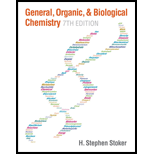
Concept explainers
Interpretation:
The condensed structural formulas for the three different ethers formed when a mixture of methanol and 1-propanol is treated with sulfuric acid at
Concept Introduction:
Dehydration reaction is the loss of water from a single reactant. Alcohol undergoes dehydration reaction to form
Want to see the full answer?
Check out a sample textbook solution
Chapter 14 Solutions
GENERAL,ORGANIC,+BIO.CHEM.-MINDTAP
- Glycine hydrochloride (Cl− H3N+CH2COOH) is a diprotic acid that contains a carboxylic acid group and an ammonium group and is therefore called an amino acid. It is often used in biochemical buffers. Solve, In analogy with Figure , sketch the titration curve of this diprotic acid.arrow_forwardGive the reagent or chemical test that would differentiate the following pairs of compounds. Write chemical equations for the reactions. List of Chemical Tests (choose here)I. Halogenation: Bromination with and without lightII. Oxidation: Reaction with Baeyer’s reagent III. Reaction with Ammoniacal Silver Nitrate (AgNO3) or simply Tollen’s reagent a. benzene and ethylbenzeneb. 1-butyne and 2-butynec. 2-methylpentane and 2-methyl-2-pentened. toluene and 1-methylcyclohexenearrow_forwardIf the dehydration reaction of an alcohol is successful, what changes would be seen in the IR spectrum for the product compared to the starting materialarrow_forward
- Using the picture provided, match the correct name of each of the functional groups highlighted in blue.arrow_forwardWhich of the following would you expect to elute first from a silica gel column eluted with hexane: B-carotene, chlorophvll A. or chlorophvll B? Provide a brief iustification for vour answerarrow_forwardThe doctors order 750mg of amoxicillin for your patient. A 1g vial of powdered amoxicillin is available. The label says to add 9ml sterile water to yield 1g/10ml. How many milliliters of reconstituted amoxicillin should you provide?arrow_forward
- للتدة Consider the following compounds. O 2 3 Use the numbers shown to answer the following questions. If none of the structures is applicable enter the word none. An anhydride is represented by the structure numbered O O HC 1 CH3 HC 3 CH3arrow_forwardA 1.000-g sample containing bromide was dissolved in sufficient water to give 100.0 mL. A 50.00 mL aliquot was measured and after acidification, silver nitrate was introduced to precipitate AgBr, which was filtered, washed, and then dissolved in an ammoniacal solution of potassium tetracyanonickelate(II): Ni(CN)42- + 2AgBr(s) → 2Ag(CN)2- + Ni2+ + 2Br- The liberated nickel ion required 11.70 mL of 0.002146 M EDTA. The other 50.00 mL remaining solution was also analyzed for its Br- content by potentiometry using a metallic electrode of the second kind. e) Write the cell notation of the potentiometric set-up with SCE as the reference electrode. f) Write the Nernst equation that describes the indicator electrode set-up.arrow_forwardDraw the structures of the following acids:(a) 2-Ethyl-3-hydroxyhexanoic acid (b) m-Nitrobenzoic acidarrow_forward
- TE buffer consists of 10 mM of Tris-Cl, pH 7.6 and 1mM of EDTA, pH 8.0. You need to prepare 3L of TE buffer and you have the following stock solutions: 500 mM Tris-Cl and 1 M EDTA. How will you prepare the 3L of TE? Write work clearlyarrow_forwardIn the preparation of aspirin, You can do the functional group test to ensure the completion of the reaction. (a) What is the name of reagent used? (b) What is your observation if any unreacted starting material is present? (c) What is the name of the functional group responsible for this reaction?arrow_forwardDetermine the weight/volume of the chemicals needed to prepare the following solutions: a) 100 ml of 0.9% (w/v) saline (NaCl) b) 30 ml of 50% glycerol (v/v) c) Electrophoresis requires TAE, which is a specific mixture of Tris base, acetic acid, and EDTA. TAE is normally made as a 50X concentrated stock. Provide a recipe to make 40 ml of 50X TAE. The recipe for one liter of 50X TAE is as follows: 242g Tris base, 57.1 ml glacial acetic acid, 100 ml 0.5 M EDTAarrow_forward

